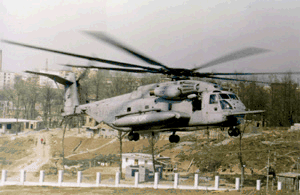
|
Some data from:
MarineLINK@USMC
|
USMC/Sikorsky CH-53 (S-65) Sea Stallion and Super Stallion
Helicopter

| Primary function: | Transportation of heavy equipment and supplies during the ship-to-shore movement of an amphibious assault and during subsequent operations ashore. |
| Manufacturer: | Sikorsky Aircraft, Division of United Technologies, USA; Luftwaffe versions license-built by VFW-Fokker, Germany. |
| Power plant: | (Early
versions) two 2,850shp General Electric T64-6 free-turbine
turboshaft; (CH-53D and G) 3,925shp T64-GE-413; (RH-53D) 4,380shp T64-GE-415; (CH-53E) three 4,380shp T64-GE-416 |
| Length: | (most
models) 88ft 3in (26.9m); (CH-53E) 99 feet 5 inches (2.64 meters). |
| Height: | (most
models) 24ft 11in (7.6m); (CH-53E) 28ft 4in (8.81 meters). |
| Rotor diameter: | (most
models) 72ft 3in (22.02m); (CH-53E) seven-blades, 79ft (24.08m). |
| Performance: | (most)
196mph (315km/h); (CH-53E) over 200mph (320+ km/h). initial climb (maximum) typically 2,180ft (664m)/min; Service ceiling, typically 20,400ft (6220m); |
| Empty weight: | (CH-53D) 23,4851b (10,653kg); |
| Maximum takeoff weight: | (most)
42,0001b (19,050kg); (RH-53D) 50,0001b; (CH-53E) Internal load: 69,750 lb (31,666 kg) External load: 73,500 lb (33,369 kg) |
| Range: |
without refueling: 621 miles (540 nautical
miles) with aerial refueling: indefinite |
| Armament: | Two XM-218 .50 caliber machineguns. |
| Crew: | 3 |
| Introduction date: | First flight 14 October 1964; service delivery (CH-53A) May 1966. (CH-53E) June 1981. |
| Unit Replacement Cost: | $26,100,000 (1996 dollars). |
| Mission: | USMC: As the Marine Corps' heavy lift helicopter designed for the transportation of material and supplies, the CH-53E is compatible with most amphibious class ships and is carried routinely aboard LHA (Landing, Helicopter, Assault: an amphibious assault ship), LPH (Landing Platform, Helicopter: an amphibious assault ship) and now LHD (Landing, Helicopter, Dock: an amphibious assault ship) type ships. The helicopter is capable of lifting 16 tons (14.5 metric tons) at sea level, transporting the load 50 nautical miles (57.5 miles) and returning. A typical load would be a 16,000 pound (7264 kilogram) M198 howitzer or a 26,000 pound (11,804 kilogram) Light Armored Vehicle. The aircraft also can retrieve downed aircraft including another CH-53E. The 53E is equipped with a refueling probe and can be refueled in flight giving the helicopter indefinite range. |
| Inventory: | USMC: (6/96) 160 |
| Background: | USMC:
Derived from an engineering change proposal to the twin-engine
CH-53D helicopter, the CH-53E has consistently proven its worth to
the Fleet commanders with its versatility and range. With four and
one half hours endurance, the Super Stallion can move more equipment
over rugged terrain in bad weather and at night.
Improvements in the CH-53E include the addition of a third engine to give the aircraft the ability to lift the majority of the Fleet Marine Force's equipment, a dual point cargo hook system, improved main rotor blades, and composite tail rotor blades. A dual digital automatic flight control system and engine anti-ice system give the aircraft an all-weather capability. The helicopter seats 37 passengers in its normal configuration and has provisions to carry 55 passengers with centerline seats installed. With the dual point hook systems, it can carry external loads at increased airspeeds due to the stability achieved with the dual point system. During Operation Eastern Exit two CH-53Es launched from amphibious ships and flew 463 nautical miles (532.45 miles) at night, refueling twice enroute, to rescue American and foreign allies from the American Embassy in the civil war-torn capital of Mogadishu, Somalia in January of 1990. Two CH-53Es rescued Air Force Capt. Scott O'Grady in Bosnia in June 1995. |
| Development: | Obviously developed from the S-61, the S-65 family includes the largest and most powerful helicopters in production outside the former Soviet Union. The dynamic parts (rotors. gearboxes and control system) were originally similar to those of the S-64 Skycrane family, but using titanium and with folding main-rotor blades. Most versions served in Vietnam from January 1967 performing countless tasks including recovery of downed aircraft. In 1968 a standard CH-53A completed a prolonged series of loops and rolls, while others set records for speed and payload. Most of the 153 CH-53D for the German army were built in Germany, together with the engines. Later versions are the RH-53D for mine countermeasures (MCM) with comprehensive tow/sweep systems and 0.5in guns for exploding surfaced mines and the three-engined CH-53E for carrying slung loads up to 18 tons. |
| Users: | Austria, W Germany, Iran, Israel, USA (Air Force, Navy, Marine Corps). |